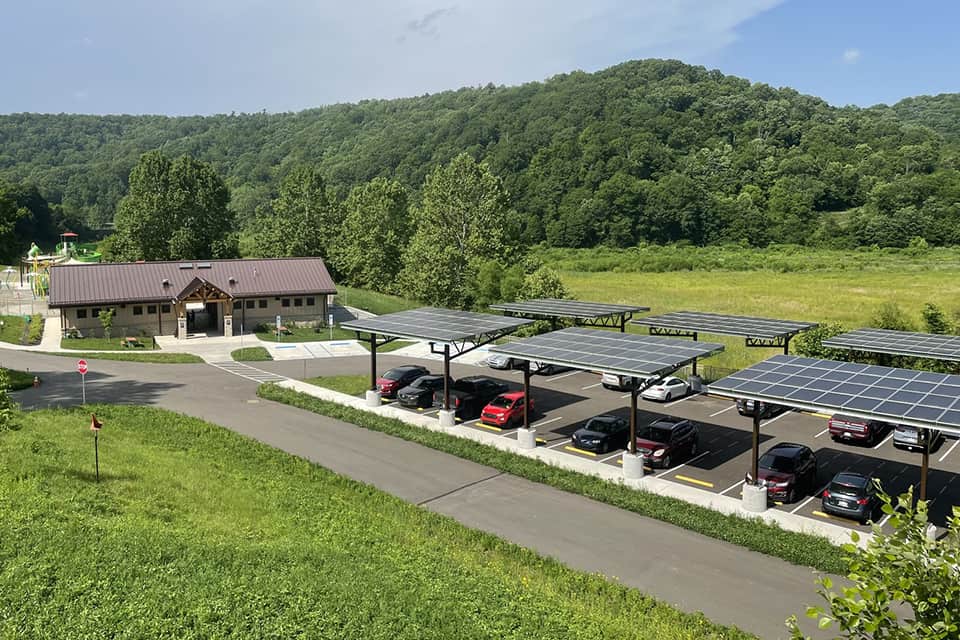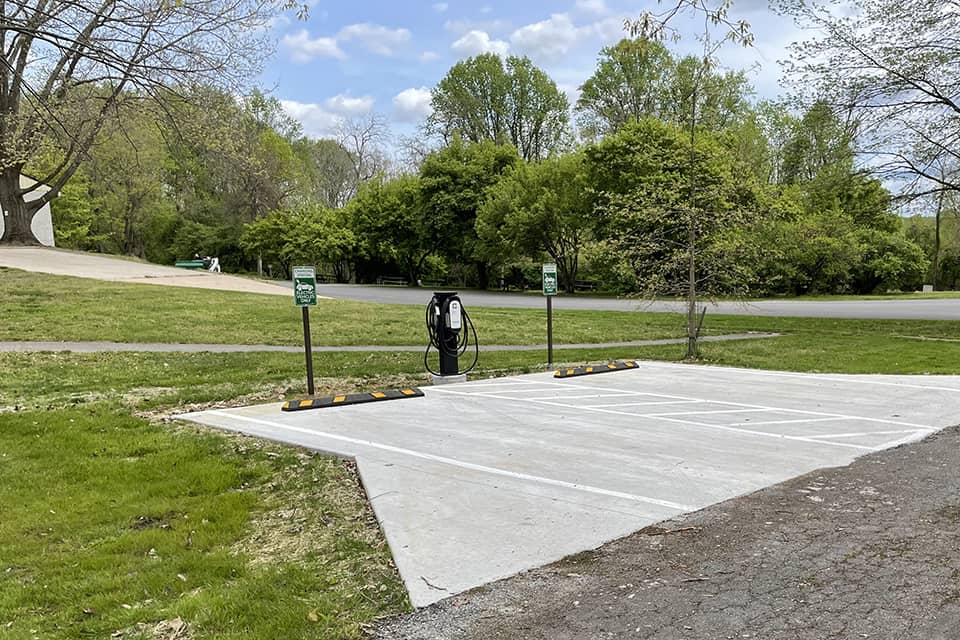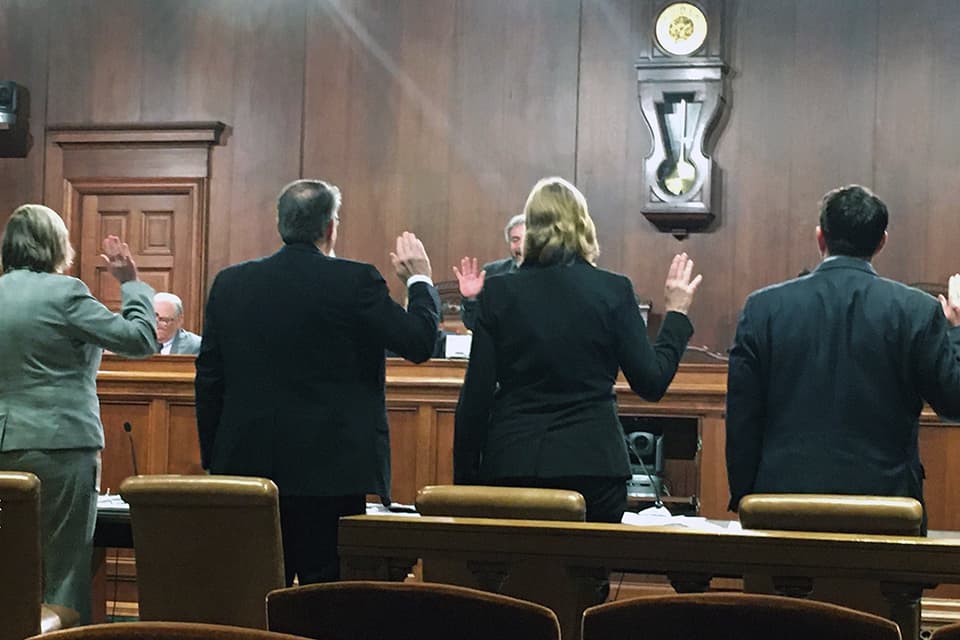Operate Effectively and Efficiently
The major DCNR accomplishments of 2022 to operate effectively and efficiently are listed below.
Carbon Capture Utilization and Storage
DCNR’s Bureau of Geological Survey continued its work on
carbon capture utilization and storage on several fronts.
The survey participates in two United States Department of Energy-funded projects -- the Midwest Regional Carbon Initiative and the 21st Century Power Plant project, providing subsurface data and interpretation as well as other technical work.
The bureau also continued to lead the Carbon Capture Utilization and Storage Inter-Agency Work Group. In 2022, the work group officially engaged external stakeholders considering commercial deployment of carbon capture utilization and storage and hydrogen energy projects in the Mid-Atlantic region.
This group has come to be known as the Pennsylvania Energy Horizons Cross-Sector Collaborative, and, with support from the Team PA Foundation, has recently submitted a concept paper to the U.S. Department of Energy for federal funding to support a regional clean hydrogen hub project in the region.
Geologic Mapping
DCNR’s Bureau of Geological Survey secured $261,000 in grants from the United States Geological Survey for geologic mapping in 2022. Work being conducted under the grants includes:
- Mapping glacial deposits in Butler and Lawrence counties
- Geologic mapping in Columbia County
- Surface and subsurface (three-dimensional) geologic mapping of the Broad Top coalfield in southcentral Pennsylvania
- Compilation of surficial geologic maps in southeastern Pennsylvania
- Compilation of bedrock geologic maps in central Pennsylvania
These projects produce updated and comprehensive data benefiting the counties, townships, businesses, and residents of the areas that are mapped.
Geologic data assists in making sound land use decisions, managing ground water resources, assessing mineral and aggregate resource potential, and provides more detailed information on geohazards such as sinkhole and landslide potential.
These projects also will contribute to the goal of producing a three-dimensional geologic model of Pennsylvania and to the congressionally mandated goal of the United States Geological Survey’s U.S. GeoFramework Initiative to produce a seamless two-dimensional/three-dimensional geologic model of the nation by 2030.
Critical Minerals
The shortage of critical minerals and rare earth elements is one of the most important economic and security issues facing the nation.
DCNR’s Bureau of Geological Survey is part of a $4.5 million project funded by the United States Geological Survey Earth Mapping Resource Initiative to collect airborne geophysical data over 27,500 square miles in Pennsylvania, Maryland, Virginia, and West Virginia.
Data was collected in 2022 and the states and the United States Geological Survey will cooperate on interpretation in 2023. The data will aid in understanding domestic critical mineral resources still in the ground and in mine waste.
The survey also has a separate grant from the Earth Mapping Resource Initiative to investigate cobalt-bearing magnetite skarns in southcentral Pennsylvania.
Also, on the critical mineral front, DCNR is part of a research team for the United States Department of Energy-funded Mid-Appalachian Carbon Ore, Rare Earth, and Critical Minerals Initiative.
The bureau is working with the West Virginia University Research Corporation, state surveys, and other interested parties in the central Appalachian coal basin to provide volumetric estimates of selected rare earth elements and critical minerals contained in multiple potential sources, including:
- Unmined coals
- Coal preparation and power plant wastes
- Acid mine drainage
- Organic-rich shale wastes associated with Marcellus shale gas development
Coal resource assessments are underway, as are waste stream identification and characterization.
Hydrography
DCNR’s Bureau of Geological Survey, with the support of a team of state, federal, private, and academic professionals, continues its program to maintain complete, and modernize authoritative surface water mapping for Pennsylvania.
The hydrography team continues to work closely with the United States Geological Survey to demonstrate the future of hydrographic mapping and data management. A
digital base maps page has been added to the DCNR website.
Lake Studies
DCNR’s Bureau of Geological Survey released two lake-depth maps for state park lakes in 2022: Pymatuning and Elk state parks.
Innovative Energy Efficiency Programs
DCNR continues to pursue Guaranteed Energy Saving Act eligible projects across its properties to:
- Improve lighting to LED (light-emitting diode)
- Install more efficient heating, ventilation, and air conditioning systems
- Improve building envelopes and other upgrades
DCNR has 23 solar arrays with a total capacity of 1.2 MW (megawatt). These arrays will save $157,600 on electricity and reduce greenhouse gas emissions by about 443 metric tons (equal to one million passenger car miles) annually.

New solar shading structures Ryerson Station State Park
Charging Stations for Electric Vehicles
There are more than 40 public
electric vehicle charging stations that now serve as proving grounds to improve accessibility and range for park visitors who drive plug-in hybrid or full electric-powered vehicles.
When the current slate of projects is complete, more than 50 DCNR-affiliated locations will have electric vehicle charging stations in 2023.

New electric vehicle charging station at Marsh Creek State Park
Electric Vehicle Fleet
DCNR boasts 36 electric and plug-in vehicles in its fleet. The agency is working to replace 25 percent of its passenger vehicle fleet with electric vehicles in the next several years.
Forest Fire Protection
Approximately 185 DCNR Bureau of Forestry and volunteer firefighters were deployed to battle blazes in numerous states across the nation in 2022.
Assisting other states provides valuable training and experience for Pennsylvania firefighters that can be applied when responding to future wildfires at home.
Pennsylvania also experienced an active wildfire year, with approximately 950 wildfires burning about 2,600 acres in 2022.
The largest fire of the year burned about 700 acres in Centre County during early November.

Nighttime view of Centre County wildfire in November 2022
Prescribed Fire
DCNR personnel safely conducted 63 controlled burns on 1,500 acres of DCNR-managed lands -- reducing hazardous fuels and helping to restore fire dependent and adapted ecological communities.
Communications and Outreach
DCNR’s Bureau of Forestry answered more than 1,100 natural resource and recreation questions posed by the public. This total represents about a 10 percent increase from 2021.
The bureau responded to intense interest in fall foliage, interviewing with at least 14 media outlets and providing comprehensive, statewide reporting for six weeks.
The Bureau of Forestry also launched a new,
quarterly electronic newsletter to reach forestry stakeholders and connect them to the agency’s important work. In its first year, the email newsletter garnered 10,000 subscribers.
Continuous Process Improvement
DCNR offers many opportunities for scientific study. Both state parks and state forests had separate applications for researchers and academic institutions to request permission to conduct studies on state park or forest land.
Staff centralized the application process and created an online application form available on the DCNR website for researchers to apply.
This has saved staff and applicants approximately 140 hours a year and reduces the back-and-forth communication on application errors.
Camping Reservations and Point of Sale in State Forests
In November 2022, reservations for campsites and firewood permits in state forests were added to the state park
online reservation system. Previously, paper permits were obtained from state forest district offices.
This change allows DCNR to manage the process in a modern and more efficient way and allows the department to evaluate and make improvements to designated campsites in forests.
Policy Modernization
DCNR policies have been standardized and now have consistent formatting and a numbering system that is being using throughout the agency.
Policies are available on the employee intranet which will allow for policies to be reviewed and updated regularly. DCNR staff also combined or removed about 26 policies that were redundant or outdated.
Business Process Modernization
DCNR has completed high-level documentation of its business processes and technology functions across the agency.
This has given the department a clearer picture of the risks involved with aging software and the ability to look at redundancies.
DCNR will be developing a roadmap to facilitate the development of a robust, configurable business technology platform to ensure the department continues to support both staff and the public in an efficient manner.
Legislative Accountability
As part of the annual budget process, DCNR Secretary Cindy Adams Dunn and deputy secretaries answered questions from senators about DCNR’s proposed 2022-2023 budget.
They used the opportunity to highlight the role of outdoor recreation in Pennsylvania’s economy, state park and forest infrastructure needs, diversity and inclusion initiatives, sustainability work, the Pennsylvania Outdoor Corps, and other topics.
In January, DCNR Director of the Bureau of Geological Survey Gale Blackmer testified before the State House Environmental Resources and Energy Committee about the challenges and opportunities related to rare earth mineral extraction in Pennsylvania.
In September, Director Gale Blackmer spoke about the opportunities for carbon capture utilization and storage in Pennsylvania and potential components of carbon capture utilization and storage framework legislation.
Also in September, DCNR Secretary Cindy Adams Dunn and Deputy Secretary John Norbeck participated in a Senate Environmental Resources and Energy Committee meeting about how federal funding from the American Rescue Plan can be spent and leveraged to improve water quality in Pennsylvania.

DCNR Deputy Secretary Lauren Imgrund, Deputy Secretary John Norbeck, Secretary Cindy Adams Dunn, and Deputy SecretaryMichael Walsh are sworn in before the Pennsylvania Senate Appropriations Committee for a budget hearing
Human Resources
The Pennsylvania Office of Administration’s Conservation and Environment Human Resources Delivery Center continues to work on standardizing human resources processes. Accomplishments include:
- Implementation of a new commonwealth-wide hiring process, which streamlined job placement and filling processes
- Continued expansion of job recruitment activities with organized job recruiters geographically located across the state to help meet job recruitment needs of state parks and forests.
- DCNR conducted its first onsite hiring event at Nockamixon State Park in 2022 and is planning on conducting several other hiring events in 2023.
- Conversion of the semi-skilled laborer multiple choice exam to a vacancy-based experience and training exam, which creates a more user-friendly application process and a more efficient job filling process.
- Continued improvement to the intern hiring process